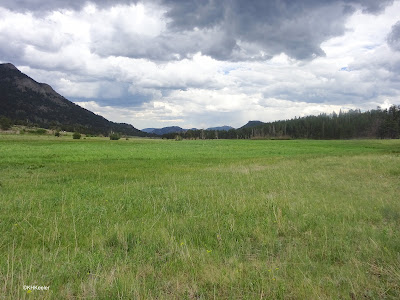 |
| burned forest, Rocky Mountain National Park |
The hill ahead was burned. Look at those sad dead trees!
So you take the fork in the trail going away from them.
 |
| meadow by burned forest, Rocky Mountain National Park |
If you are looking for wildflowers, though, walk through the burned forest. See all that green on the ground?
All plants need the same things for growth: air, water, light, soil nutrients. As a result they often compete, usurping the resources another plant would have used. A tragedy for some plants is an opportunity for others. In particular, the pine trees that dominate the Rocky Mountain forests shade out and take water from the small herbaceous plants that grow beneath them. The fire killed or burned back the branches that shaded these hillsides and removed the water and soil competition by the trees, so many little wildflowers have a particularly good year after a fire. (Their top was burned off but it would have died in winter anyway. They get an additional benefit because the ash provides burst of nutrients,)
Western wallflower (Erysimum capitatum, cabbage family Brassicaceae). These bright yellow or orange- flowered plants are natives that live scattered across the mountain ecosystems, but often bloom prolifically after fire.
 |
| Western wallflower (Erysimum capitatum) |
Likewise, blanketflower, Gaillardia is a short-lived perennial that thrives when the forest becomes sunnier. This is the western species of blanketflower, Gaillardia aristata. They tend to be yellow with a red center in Rocky Mountain National Park. A highly camouflaged moth (Schinia masoni)--red and yellow!--that eats blanketflower is much more abundant after a fire. It sits on the flower, very hard to see. I looked but did not see one. On the flower in the lower left is an ambush bug (Phymatinae) hoping to capture and eat a pollinator.
 |
| Gaillardia aristata great blanketflower |
 |
| groundsel, Senecio |
The hillside looked unpromising but I saw three species of larkspur, Penstemon, in bloom (below),
 |
| burned forest |
A short penstemon with relatively large blue flowers
A soft purple penstemon. Also in this photo, in the lower left, curling stalks with gray balls, are flowering shoots of prairie sagebrush, Artemisia frigida. (sunflower family, Asteraceae) It forms low carpets, tripling or quadrupling in height when it flowers.
And this, medium-height, rather sprawling blue penstemon:
Blackened branches lay on the ground, increasingly covered by green leaves:
Also part of the rebirth after fire is the germination of seedlings. All these little green spots (below) are tiny plants of prairie sagebrush, germinating in areas cleared off by the fire. Some will survive, though in a year or two, pines will shade the area again, slowly growth for sagebrushes.
 |
| Many seedlings of prairie sagebrush, Artemisia frigida |
The Rocky Mountain forest is always a contest between plants, dry conditions favoring grasses and other plants from the plains to grow at ever higher elevations, wetter conditions allowing tree seedlings to survive farther downslope to shade out shorter plants. Fire sets the trees back, making meadow plants very happy, but in five or six years the tree seedlings will have grown taller than the grasses and wildflowers, and times will be good for trees but hard for herbs living under them. Because years vary and fires happen, this has always been a dynamic system. Global warming will keep the trees higher on the mountains and invite southern plants, for example, New Mexican wildflowers, to move north in the Colorado Rockies. The event that one plant loves makes another shut down growth to wait it out.
 |
| Burn damage is not very visible, between the trees, Rocky Mountain National Park |
Hidden treasures in what looks like a bleak area.
 |
I heard thunder. Overhead the clouds were darkening and the wind had started to blow in gusts. I took it as a warning and headed back to the parking lot. I could have lingered a bit, but within the hour it poured.
Comments and corrections welcome.
Kathy Keeler
A Wandering Botanist
More at awanderingbotanist.com
Join me on Facebook: https://www.facebook.com/AWanderingBotanist






Is "larkspur" an oops? (with penstemon)
ReplyDeleteYes, Penstemon is the scientific name of beardtongues, Delphinium is the scientific name of larkspurs, not at all the same plant. Will edit.
ReplyDelete